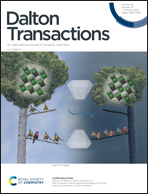A mechanochromic cyclemetalated cationic Ir(iii) complex with AIE activity by strategic modification of ligands†
Abstract
Two new aggregation-induced emission (AIE)-active cyclemetalated cationic Ir(III) complexes have been rationally designed and synthesized by introducing O–H substituents into Schiff base ligands. π-Hydrogen bonding is successfully exploited for the first time to realize the mechanochromic luminescence (MCL) property by the synergistic effect of O–H and F substituents in complex 1. An X-ray crystal structure analysis of the two complexes suggests that the intramolecular hydrogen bonding effectively restricted the molecular motions, thus causing typical AIE characteristics. More importantly, a loosely packed structure constructed from intermolecular hydrogen bonding interactions (O–H⋯π and C–H⋯F) is obtained, and it is susceptible to mechanical stimulation. Powder X-ray diffraction (PXRD) studies also prove that the MCL behavior of complex 1 is caused by the reversible phase transition from crystalline to amorphous state under grinding and solvent recrystallization, leading to a change in emission colors. A re-writable phosphorescence data recording device was fabricated using complex 1 as the active material. Our molecular design strategies provide a new avenue for achieving efficient phosphorescence materials with AIE and MCL properties.



 Please wait while we load your content...
Please wait while we load your content...